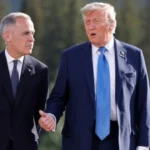
The European Union and the United States of America have aligned together to explore and fashion out ways to further trade and technological interests of both parties.
The two parties on Wednesday agreed to continue the efforts of 10 expert-level panels that had hitherto being exploring and recommending solutions to trade disputes and challenges that had bedevilled the two global entities.
In the first two days of the talks in Pittsburg, the EU and the U.S instructed the working groups to carry on with deliberations on climate, technology standards to global trade issues, and tariffs that had caused tension between the U.S. and the EU and alleged China predatory commercial practices.
The Inaugural meeting of the U.S-E.U Trade and Technology Council had the U.S. delegation being led by Commerce Secretary, Gina Raimondo, Trade Representative, Katherine Tai and Antony Blinken the U.S. Secretary of State, with the meeting taking place at a time when the EU is smarting from its exclusion from a new U.S-British-Australian security initiative. The U.S. –British-Australian collaboration was mooted to counter China’s increasing control in the Indo-Pacific region.
Commerce Secretary, Raimondo sought to quell the anger in the EU circles when he opined that the contentious Indo-Pacific dispute was not in the mandate of the TTC and therefore not a subject of discussion. Blinken and the EU delegation hailed the talks , saying it was extremely productive and cooperative as the two parties seek to push new narratives for global commerce.
“We’re working very, very closely together,” Blinken said. “When we’re working together we have a unique ability to help shape the norms and standards and rules that will govern the way technology is used; technology affects the lives of virtually all of our citizens. We have an ability to set the pace to set the standard.”
The two sides In a joint statement released after Wednesday’s discussions agreed on the need to maintain investment screening and export controls, affirmed their intention to develop artificial intelligence systems that are “innovative and trustworthy” and “respect universal human rights and shared democratic values,” and committed to partnering on a rebalance of semi-conductor supply chains.
The parties also agreed that the working group on export controls would on October 27 meet again.
The EU and the U.S. had hoped to synergize and make progress on several contentious issues, which included the U.S, tariffs on EU steel and aluminum ports, and a collaborative stance against China’s commercial policies, even though the 17-page joint statement fell short of making references to China by name.
The United States saw the opportunity of the gathering to renew its push for its antagonism of what it termed a ‘coercive and unfair trade practices by Beijing’.
The Trade and Technology Council (TTC), which was launched in June when U.S President, Joe Biden visited Europe became a focal point for brewing tensions between the U.S. and France, with plans by the government in Paris to delay the meeting uncovered.
The tensions escalated early September when the United States, Britain and Australia announced AUKUS, the new Indo-Pacific security initiative that brazenly excluded France and the European Union. It got heated that it immediately resulted in the cancellation of a multibillion-dollar Australian-French submarine contract. France in its reaction to the announcement, called a “stab in the back” by ostensible allies, and immediately recalled its ambassadors to the United States and Australia.
Notable of the complaints by the French authorities is that the E.U has an active and very vital role in the Indo-Pacific, warning that any move to blunt Chinese influence in the region without France input would be unsuccessful.
The new talks at Pittsburg is coming at a time the U.S Government led by Joe Biden is seeking to complete a review of Ex-President Trump’s government trade policies with China.
Discover more from TechBooky
Subscribe to get the latest posts sent to your email.






